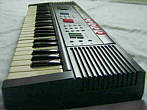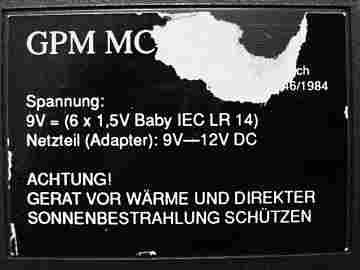| GPM | FM keyboard with accompaniment & programmable rhythm |
|
This keyboard is another strange MC-3 successor. Despite it has the same case style and button layout like an MC-3, it has no simple squarewave sound anymore but a 2 operator FM sound chip with quite warm and noble sounding timbres.
 |
 |
It was also released as PanToys MC-5000. Important is not to confuse this instrument with the MC-3000, which has the same case but contains normal MC-3 hardware.
 |
bass & chord voice select buttons addable (cycling through each 4 preset sounds). 12 higher note keys addable.
The preset sounds of this instrument seem to be a real subset of the Fujitone 6A sounds (see there). They have the typical 2 operator FM timbres and most are not programmed really realistic but resemble more classic home organ or e-piano timbres since most have very simple envelopes or contain unrealistic vibrato. But they don't sound unpleasant but have quite warm and noble sounding timbres (less rough than my Yamaha PortaSound FM keyboards) with nice bass range. Unfortunately the MC-5000 features none of the really freaky tekkno noises of the 6A, but mainly acoustic instrument imitations. But at least there are some wahwah-like synth organ timbres ('metallic synth', some brass sounds); also "duck" is no water bird voice but a synth brass sound. The 'bagpipe' sounds not at all like expected, since its sonorous woody tone has a too slow attack rate and a strong tremolo (4Hz). The 'handsaw' is a spring- like resonant metallic timbre that slowly fades silent. The 'synth brass' has a slow attack phase and fades silent. The 'chimes' has a thin metal timbre (like a clock chime) with long sustain. The 'piano' resembles a Rhodes while the 'e. piano' has a brassy timbre, sounds duller and has vibrato. The vibrato of the "vibrato" button mixes with the given one of in some timbres (both have different speeds), and also intensity varies with the actual preset sound, which makes nice textures with some timbres. The "sustain" button sets the sustain (release phase) to a fixed duration of 1 second, which can be shorter or longer than the default sustain duration of that sound. Great is also that (like most FM keyboards) the timbres are time-dynamically playable, i.e. the timbre of notes changes depends on how long a key is pressed, which provides a relatively expressive playability despite the keyboard is not velocity sensitive. Unlike MC-3, the preset sound buttons of the MC-5000 are no really good realtime sound control, because they always stop held notes when sounds are switched, and only a very quiet sustain stays audible for a second.
The percussion has the typical electronic FM timbre known from the OPL3 "MIDI synth" of early PC soundcards, which is different from the MC-3 percussion. But like the latter (see there), the MC-5000 has still the same great "custom drummer" feature to program your own drum patterns. Unfortunately a small but annoying flaw makes this one way less versatile, namely the user pattern always selects here the accompaniment of the preset rhythm it was programmed with, thus you can not intuitively switch to a different accompaniment anymore, but only select the preset rhythm with the desired new accompaniment and then manually re- enter the entire user pattern again, which is unacceptable for live performance. A strange detail is that without rhythm the polyphony reduces by 2 channels as soon any drumpad is pressed; to achieve full polyphony again, you have to press the "percussion off" button (same like "demo", plays demo when pressed twice). Such a "percussion off" button exists also on the Fujitone 6A.
The accompaniments are nicely arranged, although they sound brave and
fairly establishment and contain nothing really unusual. Interesting is
only that there is a "variation" button, with that you can switch back
and forward to a second (usually more complex) accompaniment pattern (e.g.
with additional arpeggio). Such a button exists on the similar looking
Penrod
AJ-430, although the latter has squarewave sound (like MC-3) and
different patterns. The Fujitone 6A otherwise has no variation button.
The individual intro, fill-in and ending patterns (the latter 2 with accompaniment)
are a nice detail, although also establishment. Fortunately the fingered
accompaniment accepts also disharmonic key combinations and not only a
few establishment chords.
circuit bending detailsThe GPM MC-5000 is based on the CPU "SC-MC-5" (crystal clocked @ 3.58 MHz) and the FM sound IC "MC9003".The CPU is very likely a software variant of the "MC-3DX" found in MC-3 hardware. The different clock rate of 3.58 MHz is also used for the FM IC.
keyboard matrixThe keyboard matrix layout has similarities with MC-3, but has more outputs to support 61 keys and 2 digital volume slide switches for chord and rhythm. (The sliders don't need locking switches. Volume 0 = mute.) Also here the matrix outs are multiplexed with panel LEDs. Empty matrix places do nothing. As eastereggs there are bass & chord voice select buttons and 12 higher note keys.
The input lines are active-low, i.e. react on GND. Any functions can
be triggered by a non- locking switch in series to a diode from one "in"
to one "out" pin.
pinout MC9003The "MC9003" (24 pin DIL) is the FM sound IC used in some MC-series keyboards made by Medeli. The "MC-9003A" in Fujitone 6A is likely the same and only differs in a clock out pin. Although no exact specification is known and pinout differs, there are strong similarities with the low cost OPLL sound IC Yamaha YM2413B.These sound ICs are likely identical with the "UMC U3567" (same pinout) found in Korean slot machines. The similar "UMC UM3567" differs in its DAC output that needs no external 2.2k pulldown resistors (distorts if present), but instruments with MC9003 and MC-9003A both have those resistors installed. (Thanks Traktor for info. Pinout explained on www.msxpro.com. An MP3 demo song on that site seems to sound even a bit clearer when played through U3567 than through a genuine YM2413.) The original YM2413B comes in a smaller package (either 18 pin DIL or in SMD as 24 pin SOP) and the position of NC pins differ, but the order of function pins is the same, so possibly the same die got only repackaged to enshroud what it was. Even the specified clock rate of 3.579545 MHz matches well. The YM2413B can do either 9 note polyphonic melodic timbres or 6 melody sounds + 5 rhythm sounds. The IC has 2 analogue outputs for melodic and percussion sounds. Like in the DSG YM2163, the internal 9 bit DAC outputs all channels as timeslices, i.e. the 9 polyphony channels are time-multiplexed analogue signals (an absent or mute channel stays zero) with high resistance sections in between. So the output looks like a comb-like HF pattern that is AM modulated with the audio signal. With monophonic sounds the "envelope" exactly corresponds the audio, but increasing polyphony does not increase the output voltage but the density of the tines (representing channels "1, 2, 3,... , 8, 9, 1, 2, 3,... ,8, 9..." and so on) with fewer empty gaps in between. While it may look complicated to extract sound from this, like with PWM a simple capacitor against GND is sufficient to demodulate this into an audio signal. The reason for this strange time slicing was likely to avoid additional higher DAC bit hardware for polyphony, because the summing is simply done in the capacitor, so complicated DAC extensions and digital additions could be omitted (despite resulting quality like 12 bit). Theoretically another benefit is that (without capacitor) the polyphony channels can be separated by external sample & hold networks to add more individual outputs. The YM2413B was designed for systems with tiny memory, thus its internal ROM already contains 15 preset instrument sounds; only the 16th sound is in RAM and thus freely programmable by an external CPU. But even here most synth parameters have low bit depth (e.g. 4 bit per envelope ADSR value). A variant with changed preset sound set was Yamaha YMF281. I suspect that the actual MC9003 is more versatile, because experiments with its data lines reveal that it can redefine things like percussion pitch, those have no accessible register value in YM2413B specs. This pinout is based on my own examination and the Yamaha YM2413B
datasheet; pin names were taken from there.
All "NC" pins are high resistance (tested with 1k against GND and +Vs) and likely unconnected dummy pins. Pin 11 outputs 1.8V DC at high resistance. Touching it distorts tone (mains hum modulates clock on/off). When pulled hi (through 1k resistor) it stops clock; pulled lo (through 1k) does nothing. So it may be no actual clock out but rather a reference voltage. The "MC-9003A" IC in my Fujitone 6A has here a real clock out, showing a triangular wave of about 3 MHz (measured on analogue scope, which is not accurate). NC pins and wiring are the same. In GPM MC-5000 and Fujitone 6A pin 14 is connected with 15, i.e. data bus is high resistance while not written. I.e. the CPU can never read data from the sound IC. Traktor told me that his First MC-6A (labelled only "First" on instrument, "MC-6A" on the box) contains an "MC9003" (without the A). |
Regarding the CPU type label, also an MC-5000 variant called
"MC-5" may exist, which appears to be the genuine name of this hardware
class (e.g. MC-3 keyboards (like
Letron MC-3)
also have "MC-3" in their CPU name). A similar FM keyboard was the MC-55
(case resembling MC-3A with different drumpads. I own one.) A technically
direct successor of the MC-5000 was released as
Fujitone
6A (aka MC-6A), which has a spacey case design and 100 FM
sounds with many great grainy tekkno noises. Another close successor was
the fullsize Letron MC-103 (very
similar accompaniment).
| removal of these screws voids warranty... | ||
 |
||
|
|